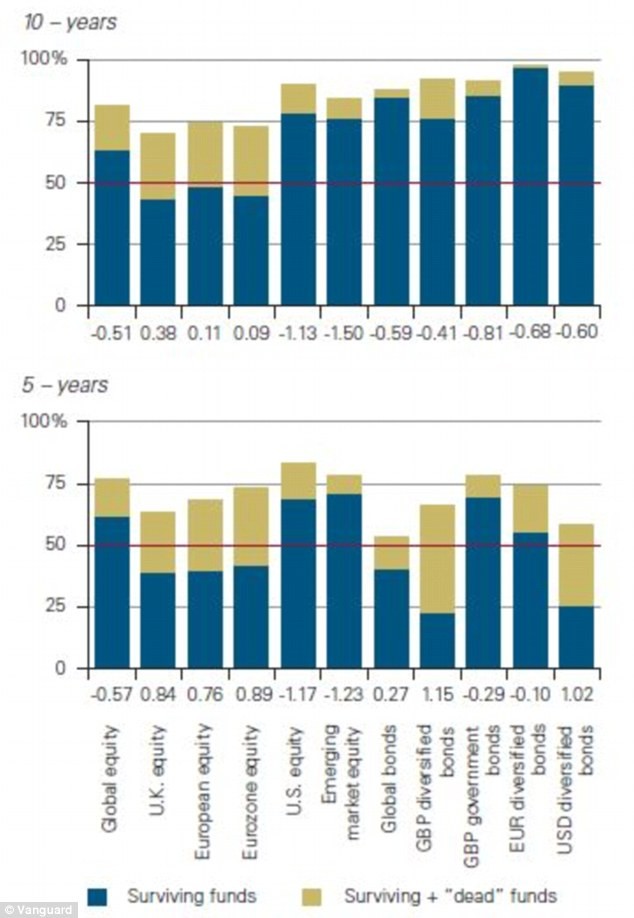Why index funds beat active strategies
Post on: 24 Май, 2015 No Comment

Spotlight
Proponents of both types of investing have argued about this for years. Bankrate checked the Standard & Poor’s Indices Versus Active Funds Score card to review recent results. Generally, over most rolling five-year calendar periods, the indexers win.
For example, over the five-year period ending in December 2008, the S&P 500 outperformed 72 percent of its active large-cap competitors; the S&P 400 MidCap index beat 79 percent of active mid-cap funds; and the S&P SmallCap 600 pummeled nearly 86 percent of active small-cap funds.
The tally at midyear 2009 was more mixed. The report says the latest data for stock funds can be interpreted favorably by active and passive investors, depending on whether they look at equal-weighted averages or asset-weighted returns.
Nevertheless, we wanted to find out why the odds are so much better for investors who employ an indexing strategy. Who better to ask than the index fund king at Vanguard, the firm famous for its offerings of low-cost index funds.
An occasional marathon competitor, Michael Buek has been running Vanguard’s index funds since April 2005, and he also helps run Vanguard’s actively managed quantitative funds. He took time out of his hectic schedule to share his perspective about the indexing strategy.
At a glance
Name: Michael Buek, CFA
Hometown: Kennett Square, Pa.
Education: B.S. University of Vermont; M.B.A. Villanova University
Career highlights:
- A principal in Vanguard Quantitative Equity Group.
- Joined Vanguard in 1987; has been on the trading desk since 1991.
- Performs the trading function for the Quantitative Equity Group.
- Earned a CFA certification in 1998.
Why is the S&P 500 so hard for large-cap money managers to beat?
I would say that it comes down to two primary factors — costs and market efficiency. The case for indexing is based in the belief that before costs, the market is a zero-sum game. For every stock trade, there is a buy and a sell, representing a winner and a loser. For every investor that outperforms the market, another investor has to underperform. In aggregate, investors are unable to beat the market because they are the market — half of investors will win, half will lose.
However, when investment costs are factored in, the average investor no longer earns the market rate of return. Those average returns are significantly eroded by costs. For example, if an investment manager charges 2 percent a year to run a fund, he or she has to consistently outperform the index by 2 percent just to match the market’s return. And that management expense doesn’t include additional transaction costs required to buy and sell securities, which can be quite high, as active managers typically have higher turnover of names in their portfolios. Therefore, investors who own the entire market at a very low cost should outperform most active managers over the long run.
Second, markets are very efficient and hard to beat. There are thousands of skilled professionals trying to buy and sell stocks and add value, and most information is already reflected in a stock’s current price. It is very difficult to find a manager that has the skill to consistently — and over long periods of time — buy the right securities at the right time, and sell them at just the right time. We don’t live in Lake Wobegon where all investment managers are above average. Very few managers have outperformed the markets consistently.
“Even the mighty can fall, as we’ve seen all too clearly this year. Markets are dynamic, and market leaders do indeed change, sometimes, quite rapidly.”
Could one reason the indexing strategy outperforms be that once a company lands on the S&P list, it’s automatically in huge demand by index funds?
Not really. Generally, S&P preannounces index additions. In the days leading up to the stock’s official addition to the index, active managers have the opportunity to buy the stock, and there are far more active managers than index managers. S&P 500 index funds only make up about 10 percent of the U.S. investment market. Many active managers that use the S&P as a benchmark prefer to have exposure to all or most of the stocks in the S&P. If Microsoft is 2 percent of the index, they may match the index with a 2 percent weight in their portfolio, or based on their research, may own less or more. In this way, they don’t risk potentially omitting a strong-performing stock altogether, but they can limit or increase their exposure based on their convictions.
Indexing is supposed to be a passive strategy, yet companies come and go from the S&P 500. Nearly 40 companies fell off the list in the year through August, and 100 were replaced over the past three years. Why so many changes in an index that’s supposed to represent the biggest and best in America?
advertisement
Even the mighty can fall, as we’ve seen all too clearly this year. Markets are dynamic, and market leaders do indeed change, sometimes, quite rapidly. The advantage of holding a very broadly diversified portfolio, like the S&P 500, is that no company typically makes up more than a few percentage points of your overall portfolio. If you own an individual portfolio of 20 or 30 stocks and one fails, it represents a much more significant hit to your bottom line than if your portfolio has hundreds or thousands of names. Of course, the reverse is true on the upside.
I will note that the S&P 500 only measures the largest companies in the country, and we typically recommend that investors own the entire market. For example, the MSCI U.S. Broad Market Index covers more than 3,000 large, medium and small companies, so as companies grow and shrink, they will continue to be represented in that index, just in varying proportions.














